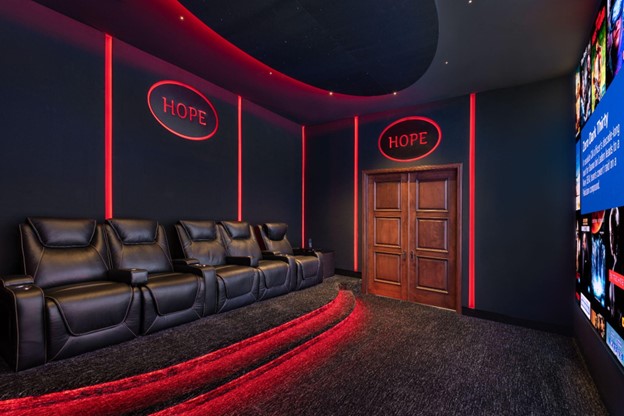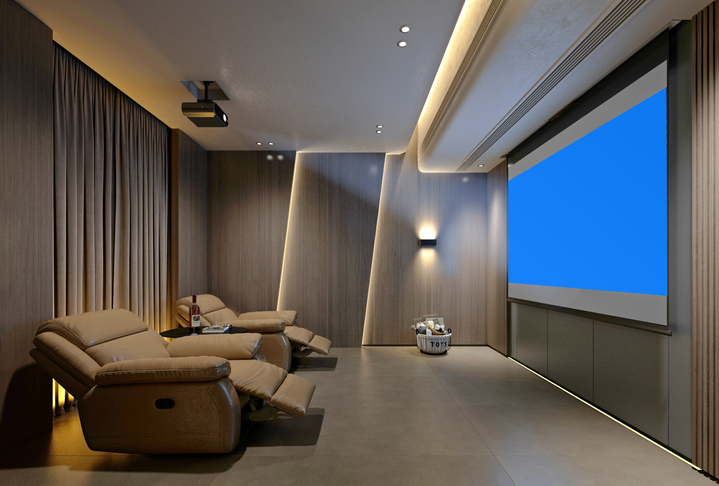Home Theater 101: Whatever You Required to Know for a Cinematic Experience in the house
Creating a home theater that rivals the cinematic experience of a commercial theater entails cautious consideration of multiple parts, including screen selection, sound systems, and room layout. Each element plays a pivotal function in accomplishing the preferred ambiance and functionality. Whether you are considering the ideal display dimension or the complexities of border noise, understanding these fundamentals is vital. As we discover these critical elements, it becomes noticeable that the options made can significantly impact your overall watching experience, leaving one to ponder how these decisions will form your personal cinema.
Picking the Right Screen
When establishing a home theater, selecting the best display can make or break the viewing experience - tampa home theater installation. The screen acts as the centerpiece of your configuration, affecting image high quality, seeing angles, and total visual. Secret aspects to take into consideration include screen resolution, size, and type
First, figure out the appropriate display size based upon your area dimensions and seating distance. A general guideline is to rest approximately 1.5 to 2.5 times the diagonal display dimension for optimum viewing. Next off, pick between various display types, such as fixed-frame, motorized, or retracting screens, each offering unique benefits. Fixed-frame displays typically provide the best image quality, while motorized choices enable versatility in area use.
Resolution is an additional critical aspect. For a genuinely immersive experience, think about a screen designed for 4K and even 8K content, making certain intensity and quality. Additionally, consider the display's gain, which impacts brightness and comparison; a higher gain can enhance brightness in well-lit areas, while a lower gain might be more suitable for darker environments.
Selecting Audio Equipment
Audio equipment is an essential part of any kind of home movie theater system, significantly enhancing the general viewing experience. The selection of audio gear can figure out the deepness, clarity, and immersion of noise, essential for producing a cinematic ambience.
When picking audio equipment, take into consideration a border audio system, which usually consists of a receiver, multiple audio speakers, and a subwoofer. A 5.1 or 7.1 network system is advised, where the very first number represents the speakers and the second the speaker, offering an immersive soundscape. The receiver is the heart of the system, managing audio and video clip signals, and need to sustain modern layouts like Dolby Atmos for an improved spatial experience.
Quality speakers are vital; look for models that supply a well balanced sound account with great bass feedback. Floor-standing audio speakers can generate richer audio, while shelf choices conserve space. Additionally, take into consideration wireless alternatives for ease of installment, although wired systems usually provide remarkable performance.

Ideal Seating Plans
Creating an excellent home movie theater experience hinges substantially on ideal seating setups. The arrangement of seats plays an important function in both comfort and checking out quality, directly affecting the overall cinematic experience.
First, think about the display dimension and viewing distance. A typical standard is to position seats at a distance approximately 1.5 to 2.5 times the diagonal dimension of the display. This makes certain an immersive experience without stressing the eyes.
Next, altitude is important. The back rows must be greater than the front to prevent obstructions if your seating is in a tiered format. For flat seating, make sure that the front row is not also near the screen, and that everybody has a clear view.
In addition, consider the plan in terms of social dynamics. Group seating can improve the common experience, while private seats might be chosen for personal watching.

Finally, prioritize convenience with ergonomic seating that supports prolonged viewing periods. Including reclining chairs or cushioned seats can substantially improve the experience, making the home cinema a favored location for both entertainment and leisure.
Lighting and Setting
Effective lights and ambiance are essential components of a properly designed home cinema, as they considerably affect the checking out experience. The ideal lighting can improve the motion picture feel, while inadequate options can diminish it. For optimal results, consider a split illumination approach that includes ambient, job, and accent lighting.
Ambient illumination supplies general lighting, making sure that the room is not totally dark, which can stress the eyes. Dimmer switches are very suggested, permitting modifications based upon the material being checked out. Task illumination, such as wall sconces or floor lamps, provides useful lighting for tasks like analysis or browsing the room without interfering with the total ambience.
Accent illumination can be utilized to highlight architectural features or create centerpieces, including depth and passion to the space. LED strip lights behind screens or along racks can supply a refined radiance that boosts the aesthetic experience without overwhelming the viewer.
:max_bytes(150000):strip_icc()/home-theater-room-getty-vostok-57f55aeb3df78c690f118170.jpg)
Wiring and Installation Tips
A tactical circuitry setup is crucial for achieving ideal performance in your home cinema system. Proper circuitry not only makes certain high-quality audio and video signals yet additionally improves the total visual of your room. Begin by mapping out your design, identifying where each part will be positioned, including a knockout post your screen, audio speakers, and receiver.
When picking wires, prioritize top notch, properly evaluated wiring to reduce signal loss. HDMI cords need to be utilized for video clip links, while audio speaker cord must match the requirements of your speakers and amplifier. Go with in-wall rated cables to abide with security standards and keep a tidy appearance.

Final Thought
In summary, developing a remarkable home movie theater experience calls for careful factor to consider of various elements, consisting of display option, audio devices, seating arrangements, lighting, and electrical wiring. Each component plays a vital duty in achieving optimum efficiency and ambiance, eventually enhancing the enjoyment of home entertainment. By focusing on these factors, a cinematic atmosphere can be effectively replicated, enabling immersive checking out experiences that rival traditional cinema settings. Attention to information in each area is essential for general fulfillment.
Developing a home movie theater that measures up to the motion picture experience of an industrial theater includes cautious factor to consider of multiple elements, including the original source screen choice, audio systems, and area layout.When setting up a home cinema, choosing the ideal screen can make or break the checking out experience. Next, choose in between various display types, such as fixed-frame, motorized, or retractable displays, each offering unique benefits. For an absolutely immersive experience, take into consideration a display made for 4K or even 8K web content, making certain sharpness and clarity.In summary, producing an exceptional home theater experience needs mindful factor to consider of different elements, including screen selection, navigate to these guys audio devices, seating arrangements, illumination, and electrical wiring.